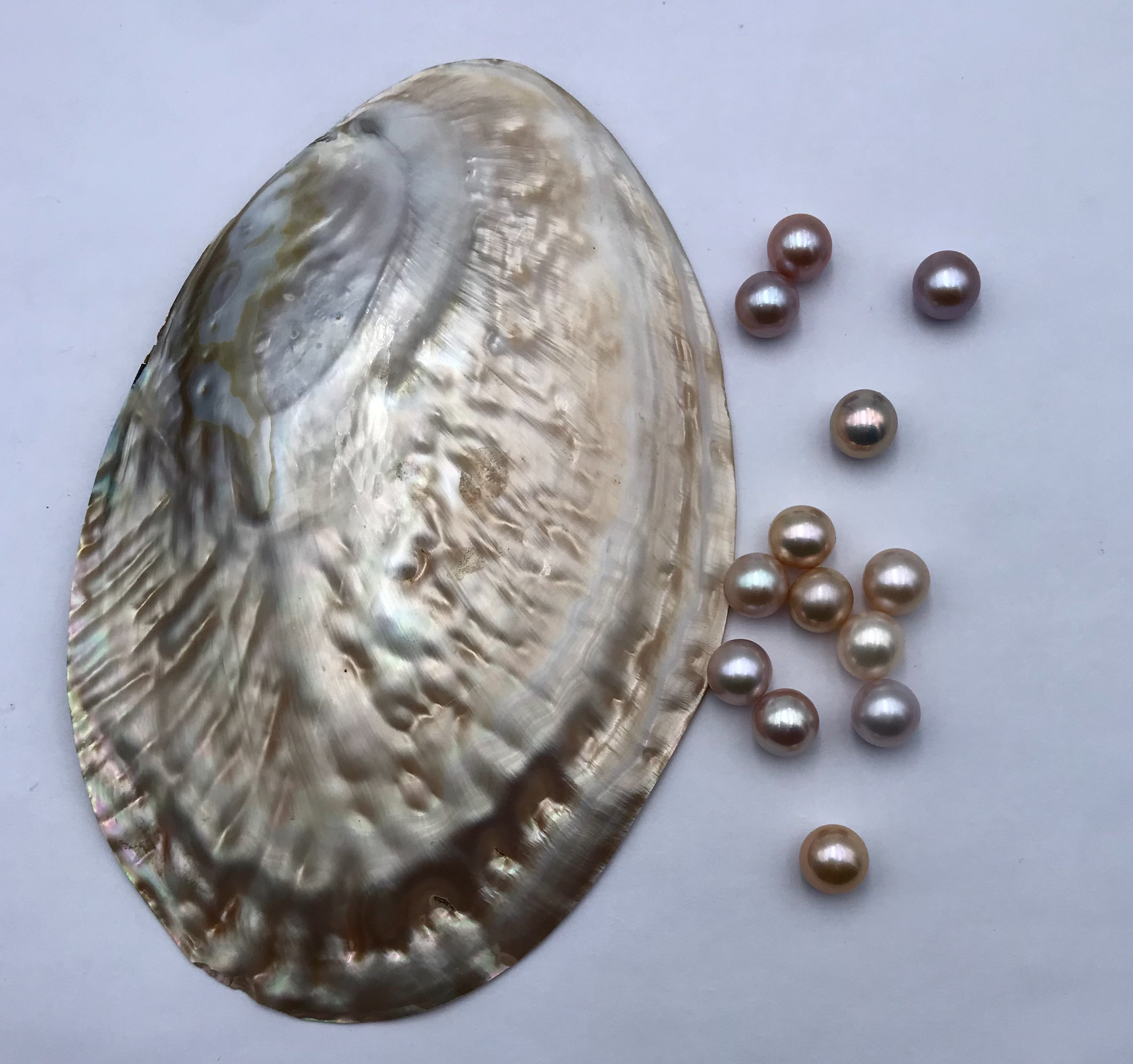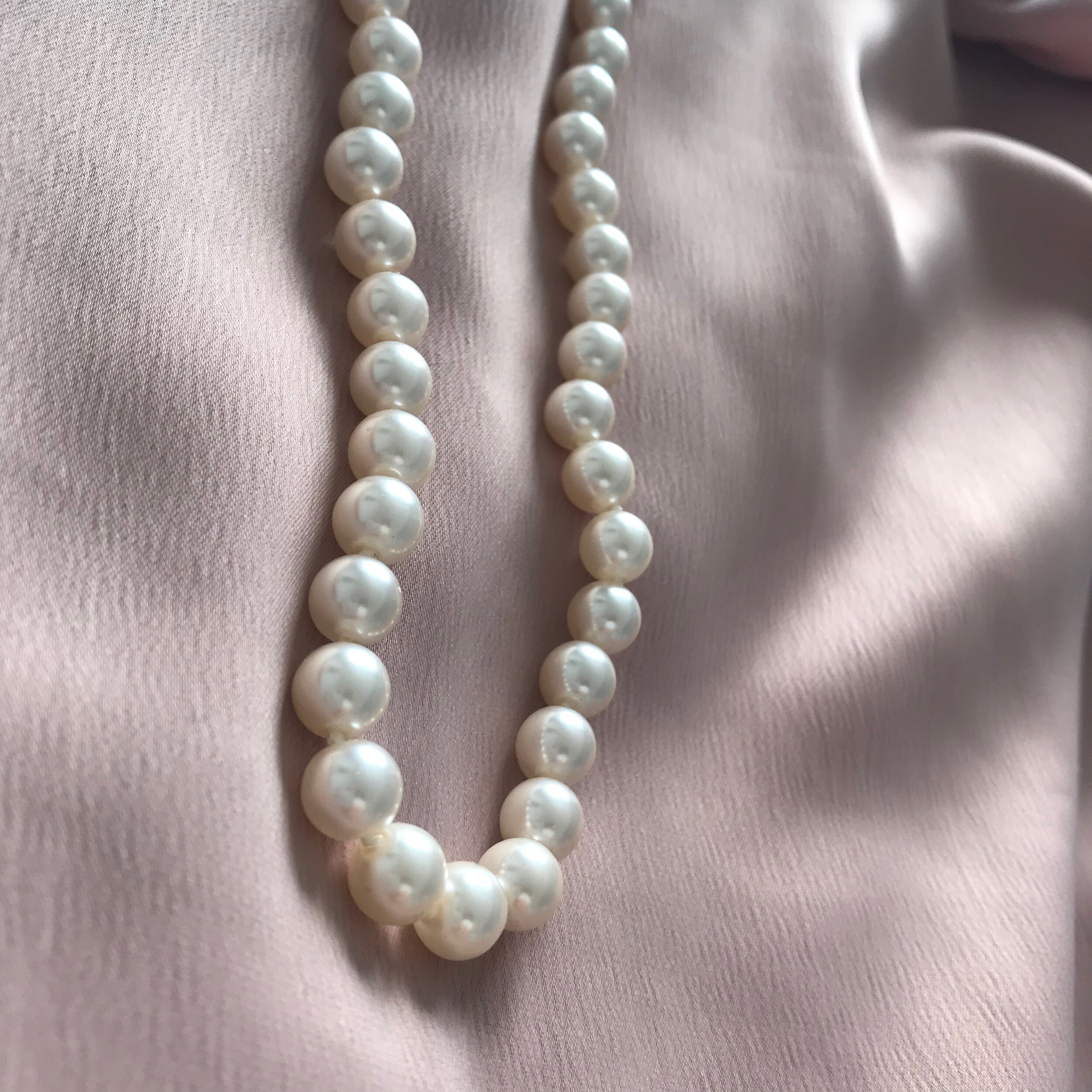
-

TAHITIAN PEARLS
Saltwater pearl
Pinctada Margaritifera - Pinctada mazatlantica - Pteria sterna, Oyster
Black-lipped pearl oyster
Bead and non-bead cultured pearl
Black, dark color
Complementary colors: eggplant purple, peacock green, metallic grey, and greenish blue, green, gold, copper, blue, pink or purple.
Size : It is usually found between 8 and 18 mm, but more frequently between 9 and 12 mm.
From French Polynesia, Central Pacific Ocean, Baja California, and Peru.
-

AKOYA PEARLS
Saltwater pearl
Pinctada Fucata - Pinctada radiata - Pinctada martensii, Oyster
Akoya-Lipped pearl oyster (Multicolor-pinkish)
Bead and non-bead cultured pearl
Varying in color from very pale pink to white, to more or less pronounced cream and rarely to bluish gray
Complementary colors: Pink, Green
Typically round shape
Found between 6 and 8 mm, although they exist between 4 and 9 mm and exceptionally up to 11 mm.
Japan is the main producer of Akoya pearls, but Hong Kong, South Korea, Vietnam and Sri Lanka also produce them in smaller quantities.
The term "Japanese pearl" usually refers to this type of pearl.
-

SOUTH SEA PEARLS
Saltwater pearl
Pinctada Maxima Oyster
Silver-lip or gold-lip pearl oyster
Bead and non-bead cultured pearl
Vary in color from white, to silvery white, to gray and golden white to bright gold
Size range from 8-20mm
From the Philippines, Indonesia, Australia, and French Polynesia.
-

FRESH WATER PEARLS
Fresh water pearls, usually in lakes, rivers or ponds
Hyriopsis cumingli or hybird
Some varieties of mussels can accommodate up to 60 pearl grafts at a time.
White-lip or pink-lip
Bead and non-bead cultured
Several shapes of freshwater pearls are available on the market, such as round, semi-round, potato, button, semi-baroque, baroque, Keshi, fireball, as well as some shapes grown with preformed cores like coins, hearts, stars or flowers.
White, from cream to light silver to a wide variety of shades of pink, purplish and coral.
Complementary colors: metallic, green, pink, etc.
These pearls range in size from 1mm (seed pearl) to 30mm for very large baroques.
China is by far the largest producer of freshwater pearls, although they are also found in very small quantities in Japan, the United States, and Vietnam, among other locations.
“The color and tones of the pearls vary according to the lighting and brightness. Note that the jewels displayed may appear different depending on the type of screen used online.”
TAKE CARE OF YOUR PEARLS TO KEEP YOUR TREASURE.
Damaged pearls cannot be restored.
Reasonable care is the key to maintain your jewels in the best condition.
For routine care, it is recommended to use soft and clean tissues after each wear, as sweating on the surface can damage pearls.
Pearls are composed of organic materials and therefore sensitive to chemicals that can alter the surface and make their luster dull and matte. It is therefore necessary to avoid any contact with cosmetics, perfume, hairspray, chlorine, and other chemical acids. Also pay attention to household products and heat sources that can dry out your pearls.
Please never use ultrasonic machine or steam cleaners for your pearls, just warm water with soap can occasionally help you.
When you see your pearls are strung, be sure the silk is completely dry before wearing them.
If you have a lot of jewels on the same box, it’s recommended to separate your metal jewels and your pearl jewels. Gems can also scratch your pearls.
Never store your pearl jewels in a plastic bag because of the chemical effects emitted by the surface.
When you prepare yourself to go outside with your pearls, make sure it’s the last thing you put on your body.
One last advice: the best way to keep your pearls radiant is to simply wear them. Pearls must maintain a humidity level above 4% to stay healthy. Like your skin, they need a little moisture and even perspiration. The moisture in your skin will help nourish your pearls.
WHAT IS A PEARL?
Pearls are a treasure from Earth resulting from the life-sustaining nature of water. Seawater and freshwater mollusks create unique pearls because of their condition, environment, and ingenuity. While natural pearls remain very rare, they are the most accessible gems worldwide thanks to advanced farming and culturing techniques. When the mantle of the mollusk is inflamed or irritated, the oyster or mussel secrete calcium carbonate with aragonite, known as pearl nacre. The pearl grows inside this simple, intriguing organism.
Luster
The luster of the pearl is undoubtedly the main criterion of quality on which to focus. It refers to the pearl’s brightness and how it reflects light. Luster is usually graded according to the following scale: Exceptional (Metallic), Excellent, Very Good, Good, Medium, and Low.
Color
The color of a pearl is subdivided into two categories; the basic color (of body) and the complementary color or colors. The basic color represents the predominant color of the pearl. Complementary colors define noticeable shades besides the main color. For example, a white pearl may have pinkish, silvery, purplish, creamy or even greenish or bluish reflections.
Some colors will have greater value because of their rarity or if the demand of the moment is greater than the offer on the market. This is particularly the case for pistachio-colored Tahitian pearls or natural violet-colored freshwater pearls.
Type of Pearl
As a general rule, saltwater pearls are more expensive than freshwater pearls because of their mode of production. In saltwater, pearls are grown in oysters, where only one or two grafts are placed at a time. In freshwater, we use mussels, which are larger and stronger mollusks that can support up to a maximum of 60 pearls at a time.
Matching
A row or pair of pearls perfectly arranged in terms of size, shape, color, luster and surface quality will always be more valuable. This is particularly the case with pearls of a special color or quality that are difficult to arrange. This criterion also applies to the row of multicolored or very baroque pearls which must nevertheless have a kinship in form, size, color or luster.
Surface Quality
The surface of the pearl represents the outer layer of mother-of-pearl. The fewer imperfections on the surface of the pearl, the higher the value. Some imperfections are more acceptable than others, for example, a ringed bead can still retain good value if the strapping is visually interesting. The same goes for some wrinkled baroque pearls. In another vein, imperfections such as scratches, cracks, marked discolorations, holes, growths or a highly stitched surface, could drastically lower the value of a pearl.
Size
Usually the bigger the pearl, the higher the price. It depends on the variety and availability of a size and its variety. There are some exceptions, such as Tahitian pearls less than 8 mm (between 7 and 8 mm), which are less abundant and rarer on the market, and therefore are a little more expensive than pearls of 8 mm to 9 mm.
Treated or untreated
Pearls can undergo several treatments that will have little to no influence on the price. A slight whitening of white pearls is very common and will not damage the luster if done in moderation. But if the bleaching is too strong, it will result in a pearl of a matte white that is unsightly. Light polishing in large churns with pieces of cork is also common practice for all types of pearls after harvest. Some scratches or slight surface defects could also be erased by a slightly more aggressive polishing.
Treatments that have a greater impact on the visual of the pearl include dyeing and irradiation. Both are intended to significantly alter the color of the pearl. Irradiation is mainly used on freshwater pearls since they contain isolated manganese atoms and are the only ones to react when exposed to Gamma rays. With this treatment, we can obtain grey pearls or dark pearls (peacock) with different bluish, purplish or green reflections. It is also possible, on a smaller scale, to perform this treatment on Akoya pearls since their core is composed of freshwater mother-of-pearl and their outer layer of mother-of-pearl is thin enough to reveal the color of the nucleus in transparency. We can therefore obtain pale gray pearls.
A tinted or irradiated pearl will not be worth less than it was worth before being treated, and sometimes even a little more due to the work done. But beware of dark freshwater pearls that are sold as Tahitian pearls for a higher price, and of pearls that are dyed gold to imitate South Sea pearls of a higher value.
Shape
Although the perfectly round pearl is the most expensive, some other forms may also have significant value, like a perfectly symmetrical pear, a fireball or a baroque with an interesting and unusual shape. "Potato-shaped“ pearls (neither round nor baroque, but in the form of a potato), buttons and oval pearls often have one of the best price-quality ratios given the aesthetic aspect of the pearl. Baroque pearls are also a cheaper choice providing an original look.
However, a pearl with a perfect and symmetrical sphere of equal quality will always be more expensive than another form.
Thickness and Quality
When we talk about the thickness of a mother-of-pearl, we refer to the mother-of-pearl layer produced by an oyster over the core. As freshwater pearls are generally grown without cores, this criterion applies only to saltwater pearls (Akoya, Tahiti, South Sea). It is especially important in the case of Akoya (Japanese saltwater pearl) because if the mother-of-pearl layer is insufficient, the pearl will have a poor luster and may even peel or chip off.
A nacre of 0.5 mm and over is considered reasonable for an Akoya, while Tahitian and South Sea pearls should have a mother-of-pearl or nacre of at least 1 mm.
What Are Keshi-Cultured Pearls?
Keshis form in both freshwater and saltwater mollusks. They are generally small in size and without precise shape, as there is no existing nucleus to guide their growth. Their luster is high and their orientation rare because they are composed only of pearl nacre.
If you are sensitive to the luster of its pearls, we have the collection "GENEREUSE" featuring the Keshi of Kasumiga, a variety of freshwater pearl.

About Silk & Polyester Fabric
To avoid any breakage of the silk thread, it is recommended to have it examined annually by an expert or Senzerina team for $50. If necessary, you may wind your pearls on a new silk thread to ensure optimal resistance.
When wet, silk can stretch if subjected to weight. This means no shower, no swimming-pool, and no sea.
To manage this we recommend you to choose the polyester fabric, it is more resistant and more secure.
“KASUMIGA”
Japan Kasumiga Pearls :
Kasumiga pearls are named after their place of origin, Lake Kasumi-ga-Ura, north of Tokyo. The mussels used for their production are called Hyriopsis schlegelii and Hyriopsis Cumingii Hybrid Mussels. We can recognize them because of their large irridescence and their unusual origin. Today, most Kasumiga pearls are Chinese freshwater pearls, which are much less expensive than pearls from Japan. Since 1990, quantities have been limited, which creates a great effect of rarity for these pearls with their multitude of complementary colors and beautiful metallic luster.
They are generally purple, pink to white. We can distinguish them by their large size which goes from 11 to 16 mm.
Natural Pearls: Bead-Cultured or Non-Bead Cultured
-
Bead-Cultured Pearls
Cultured pearls are the fruit of human assistance during their growth process. Usually the implantation of the nucleus on the mantle of the mollusk, mussel or oyster, fosters the organic secretion of nacre on the nucleus.
-

Non-Bead Cultured Pearls
Freshwater pearls do not have a nucleus, although cultivated freshwater pearls increasingly have them. This growing market features rounder pearls.





